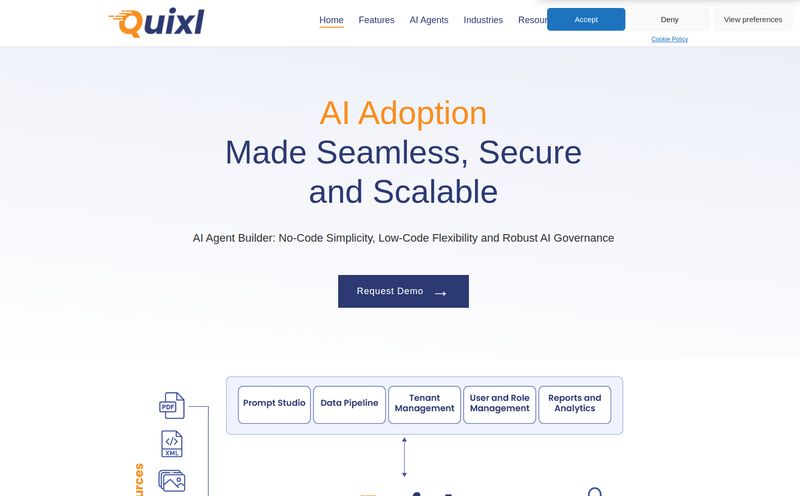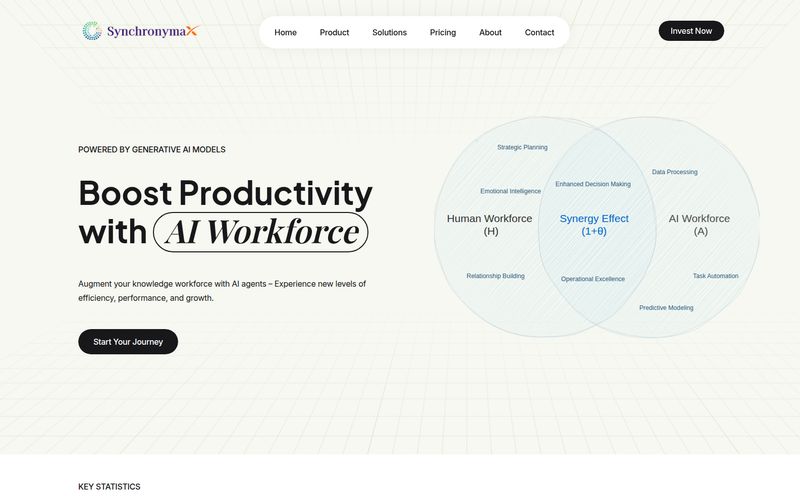We've all been there. You're staring at your email drafts, trying to find a new way to say "Just checking in" without sounding like a robot or, worse, completely desperate. The world of sales and marketing outreach has become a ridiculously crowded space. Your prospect's inbox is a battlefield, and your carefully crafted email is just one of a hundred identical soldiers trying to storm the castle. It's exhausting.
For years, we've been told personalization is the answer. Use their name, mention their company, reference a post they made on LinkedIn. And yeah, that helps. A little. But what if you could actually... show up? What if they could see your face, hear your voice, and get a real sense of the person behind the email? That's the promise of video in sales, a trend that's been bubbling for a while now. And at the heart of that trend are platforms like Vidyard.
I've gotta admit, I was skeptical at first. The idea of recording little videos of myself for prospects felt a bit, well, cringey. But the data doesn't lie, and the results companies are seeing are hard to ignore. So, I decided to take a proper look at Vidyard, one of the biggest names in the game, to see if it's really the key to success or just another tool destined to gather digital dust.
So, What Exactly is Vidyard? (Beyond the Marketing Spiel)
On the surface, Vidyard is an online video platform. Simple enough. But comparing it to something like Loom is like comparing a Swiss Army knife to a single blade. Loom is fantastic for quick, simple screen recordings. Vidyard aims to be an entire ecosystem for video within your business.
It’s designed specifically for virtual sales and marketing teams. The whole point is to weave video into every stage of your customer lifecycle. You can record and send personal video messages, sure, but you can also host your entire library of company videos (demos, tutorials, case studies) and, most interestingly, generate personalized AI videos at scale. We'll get to that AI stuff in a minute because it's a whole can of worms.
The real kicker? It plugs directly into your existing GTM (Go-to-Market) stack. Think Salesforce, SalesLoft, HubSpot, LinkedIn... it’s not meant to be a separate island. It's designed to become part of the continent where your team already lives and works.

Visit Vidyard
The Core Features That Actually Matter
A platform can have a million features, but only a few usually make a real difference in your day-to-day. After poking around, here’s what stood out to me about Vidyard.
Personalized Video Messaging That Doesn't Feel... Awkward
This is the bread and butter. Instead of that fourth follow-up email, you send a short, 60-second video. “Hey Sarah, Mike here. Just saw you downloaded our ebook on SEO trends and wanted to put a face to the name and answer any questions you might have personally.” It just hits different. It cuts through the noise and reminds people there’s a human on the other side of the screen. The stats from Vidyard’s own users boast improved click-through and reply rates, and frankly, I believe them. I’ve received a few of these myself and I almost always watch them out of pure curiosity.
AI-Powered Video: The Game Changer or Just Hype?
Okay, the AI features. This is where things get really interesting and, for some, a little sci-fi. Vidyard offers tools like AI Avatars and a “Video Sales Agent.” The idea is that you can create a digital clone of yourself to generate personalized videos at a scale no human possibly could. You feed it info from your CRM, and it spits out a video addressing the prospect by name, mentioning their company, and referencing their specific interests.
Is it a bit creepy? Maybe. Is it effective? The jury's still out on the long-term impact, but it’s a fascinating solution to one of the biggest cons of video: it's time-consuming. You can't personally record 500 videos in a day. But your AI-twin can. I see this not as a replacement for genuine, personal video but as a way to supercharge that initial, top-of-funnel outreach where scale is everything.
Centralized Video Hosting for Your Entire Team
This sounds boring, but it's hugely important. If you’re a growing business, your video assets are probably a mess. Some are on YouTube, a few are on a shared drive, your top salesperson has a bunch of great demos saved to their desktop... its a nightmare. Vidyard gives you a single source of truth. A secure, professional, and—most importantly—brandable place to host everything. You get analytics on who’s watching what, how long they're watching, and you can ensure everyone is using the most up-to-date, on-brand messaging.
Integrations That Make Your Tech Stack Sing
For any sales or marketing ops person, this is the most critical part. A new tool that doesn't talk to your existing tools is a dead-on-arrival. Vidyard's strength lies in its deep integrations. Being able to create, send, and track videos from right inside your Salesforce or HubSpot instance without switching tabs is a massive workflow improvement. It's like the universal adapter for your video content, letting you plug it directly into the outlets your team already uses.
The Proof is in the Pipeline: Does it Actually Work?
Talk is cheap, so what are the results? Vidyard loves to showcase its customer wins, and some of them are pretty eye-popping. They feature a HubSpot case study claiming that using Vidyard led to 5x more meetings booked, 4x more pipeline generated, and 25% more deals closed.
Those aren't small numbers. That's the kind of ROI that gets you a promotion. As HubSpot's Michelle Benfer puts it,
Video is now a key part of how our sales team cuts through the noise and builds trust with buyers.
And that really is the core of it. Trust. Other companies like Pavilion reported a 3x increase in pipeline, and Dooly saw a 5x return on investment. It seems that when teams commit to the strategy, it pays off.
Let's Talk Money: Vidyard Pricing Explained
Alright, the all-important question: what's this going to cost me? Vidyard's pricing is tiered, which is pretty standard for SaaS platforms. Here's a quick breakdown.
There's a Free plan, which is genuinely useful. You can record and upload up to 25 videos in total and embed up to 5 on your website. It's perfect for a single user who just wants to dip their toes in the water and see if video outreach is for them. The videos will have Vidyard branding, but hey, it's free.
The next step up is the Pro plan, at $19 per user per month (billed annually). This unlocks unlimited video creation, a 1-hour recording length limit, and gets rid of the Vidyard branding. This is the sweet spot for individual professionals, freelancers, or very small teams who are serious about video but don't need all the enterprise-level bells and whistles.
Then you have the Business and Enterprise plans. These are both "Talk to Sales" pricing models, which I know can be a bit frustrating. The Business plan is where you get the good stuff for teams: advanced analytics, custom branding, video CTAs, and key integrations. The Enterprise plan adds on things like AI video features, deeper integrations, and dedicated support. My take? The free plan is more than enough to test the concept. If you love it, the Pro plan is a reasonable investment. The Business plan is for when your entire team decides to make video a core part of its strategy.
The Not-So-Shiny Parts: A Realistic Look at the Downsides
No tool is perfect, and it’s important to go in with your eyes open. Vidyard has a couple of potential hurdles. First, there's a learning curve. It’s a powerful platform, and to really get the most out of the analytics and integrations, your team will need some training and time to adapt. This isn't just a chrome extension you install and forget.
Second, the cost can be a barrier, especially for smaller businesses. That $19/user/month for the Pro plan adds up quickly with a team of 10 or 15. The Business plan will be a significant investment, and you need to be confident that you’ll see the ROI that companies like HubSpot did.
Finally, there's the human element. The platform can't solve the fundamental hurdle of getting your team comfortable on camera. It requires a strategic shift. You have to commit to creating video content, which can feel like a big ask for sales reps who are used to just writing emails.
My Final Take: Is Vidyard Worth the Investment?
After digging in, here's my verdict: Vidyard is a seriously powerful platform, but it’s not a magic wand. It’s for teams who are ready to move beyond the tired, text-based outreach playbook and invest in a more human, engaging way of selling.
If your team is drowning in email, struggling to get replies, or looking for a way to build genuine relationships with customers in a digital world, then yes, Vidyard is absolutely worth a serious look. The potential to increase engagement and pipeline is undeniable. It’s for the company that understands that buying a tool isn't the solution; adopting a new strategy is, and Vidyard is the tool that facilitates that strategy.
But if you're on a shoestring budget, or if your team is resistant to change and allergic to being on camera, it might not be the right fit right now. And that's okay. The free plan is the perfect, no-risk way to find out which camp you're in.
Frequently Asked Questions (FAQ)
- What is Vidyard used for?
- Vidyard is primarily used by sales and marketing teams to create, host, and share videos. This includes personalized sales outreach videos, product demos, marketing content, and internal communications, all aimed at increasing leads and engaging customers.
- Is Vidyard better than Loom?
- It's not really about better or worse, but about purpose. Loom is excellent for quick, simple screen recordings and asynchronous team communication. Vidyard is a more comprehensive business platform with advanced analytics, team management, lead generation tools, and deep integrations into sales CRMs like Salesforce.
- Can I use Vidyard for free?
- Yes, Vidyard offers a robust free plan that allows you to record and share up to 25 videos. It's a great way to try out the core functionality before committing to a paid plan.
- How does the AI video creation work?
- Vidyard's AI features allow you to create an AI avatar of yourself. You can then use this avatar to generate personalized videos at scale by feeding it data from your CRM. For example, it can create hundreds of unique videos that address each prospect by their name and company.
- Does Vidyard integrate with Salesforce?
- Yes, absolutely. Deep integration with Salesforce is one of Vidyard's main selling points. It allows sales reps to create, send, and track video engagement directly from the Salesforce interface, providing valuable data on how prospects are interacting with the content.
Conclusion
The sales and marketing landscape will only get more crowded. The old tactics are producing diminishing returns. Breaking through the noise isn’t about shouting louder anymore; it’s about being more human. Tools like Vidyard represent a significant shift in how we approach business communication. It’s a move from mass-blasting to making a genuine connection. Maybe the future of sales isn’t another automated email sequence, but simply having the courage to show up, smile, and say hello, face-to-face… even if it’s through a screen.



